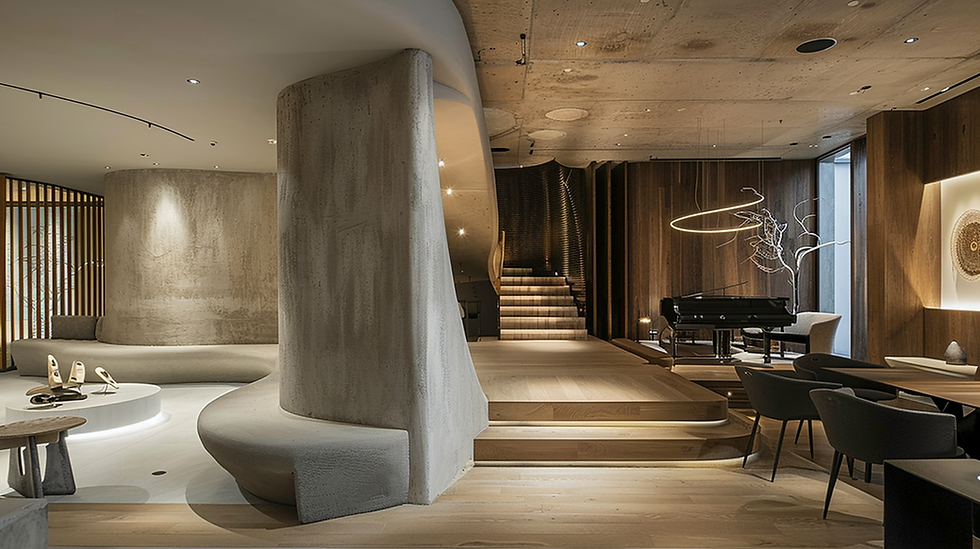Creating Spaces: Design Principles
- Daniel Carbajal Patiño

- 17 abr 2024
- 4 Min. de lectura
Welcome to our exploration of the art and science behind creating spaces!
Whether we're talking about a cozy corner of a home, an efficient workplace, or a welcoming public area, the principles of design guide us in making environments not only functional but also enjoyable.
Let's dive into how these principles can transform ordinary spaces into remarkable ones.

Understanding Space
What exactly do we mean by 'space' in design?
It's not just the physical dimensions of a room or building, but also how it's perceived and experienced by people. Space is the canvas on which designers paint their ideas. It encompasses everything from the layout of furniture to the flow between rooms.
The Functionality of Spaces

Each space we design serves a purpose. A well-designed kitchen fosters ease of cooking and social interaction, while a thoughtfully laid out office can boost productivity and well-being.
The functionality of a space is its foundation, dictating everything from the choice of materials to the layout.
The Aesthetics of Space
However, functionality isn't everything.
The aesthetics of a space greatly influence how we feel about it. This encompasses the style of decor, the choice of colors, and even the texture of the surfaces. A visually pleasing space can uplift our spirits and inspire us.
Core Design Principles
At the heart of great design are the core principles that guide every decision.
Balance
Balance is about distributing visual weight in a space. This can be symmetrical, with elements mirrored on either side of a room, or asymmetrical, which involves different objects of equivalent visual weight that create a less structured look.
Contrast
Contrast can be achieved through color, shape, and texture, creating focal points and adding interest. It's the spice of design, making spaces vibrant and dynamic.
Harmony
Harmony is achieved when all parts of the design create a cohesive whole. It's about the relationship between the elements, ensuring they all contribute to a unified theme.
Simplicity
The principle of simplicity is evident in the design of minimalist websites, where clean layouts and ample white space create a sense of clarity and focus.
Consistency
Consistency can be seen in the branding of companies like Apple, where the same design elements are used across different products and platforms, creating a cohesive brand identity.
Contrast
Contrast is used in graphic design to draw attention to specific elements, such as using bold colors against a neutral background to make important information stand out.
Emphasis
Emphasis is employed in magazine layouts, where larger fonts and vibrant images are used to highlight feature articles and grab readers' attention.
Applying Design Principles in Various Settings

Different spaces require different approaches.
Residential Design
In homes, comfort and personal expression take precedence. It's about creating a sanctuary that reflects the owner's style and needs.
Workplace Design
In workplaces, functionality rules. The design should promote efficiency but also consider the well-being of those who use the space daily.
Public Spaces
Designing for the public involves accommodating diverse groups of people and ensuring accessibility and safety, all while creating inviting communal areas.
The Role of Color and Light
Two of the most powerful tools in a designer's toolkit are color and light, both of which dramatically affect how a space feels.
The different types of design principles can also be applied in various design disciplines, such as:
User Experience (UX) Design
In UX design, principles like simplicity and usability are paramount. Designers focus on creating intuitive interfaces that guide users through seamless interactions.
Graphic Design
Graphic designers use principles like balance and contrast to create visually stunning compositions that effectively communicate messages to their audience.
Web Design
Web designers combine aesthetic, functional, and psychological principles to create engaging and user-friendly websites that leave a lasting impression on visitors.
In conclusion, design principles are the foundation of effective design. By understanding and applying these principles, designers can create designs that are not only visually appealing but also functional, intuitive, and meaningful. Whether you're designing a website, a product, or a piece of artwork, incorporating design principles will help you achieve your desired outcomes.
FAQs
1. Why are design principles important?
Design principles are important because they provide guidelines for creating visually appealing, functional, and user-friendly designs. By following these principles, designers can ensure that their designs are effective and impactful.
2. How can I learn more about design principles?
There are many resources available for learning about design principles, including books, online courses, and tutorials. Additionally, studying existing designs and analyzing how they incorporate design principles can be a valuable learning experience.
3. Can design principles be applied to all types of design?
Yes, design principles can be applied to various design disciplines, including graphic design, web design, product design, and architecture. While the specific principles may vary depending on the context, the underlying principles remain consistent.
4. What role do design principles play in branding?
Design principles play a crucial role in branding by helping to establish a cohesive visual identity that reflects the values and personality of a brand. Consistency, simplicity, and clarity are particularly important in branding design.
5. How can I improve my design skills?
Improving your design skills requires practice, experimentation, and continuous learning. Try experimenting with different design principles in your projects, seek feedback from others, and stay updated on current design trends and techniques.

Comentarios